If your lawn has reached a point where everywhere you look, there is nothing but weeds, it is time to start over. Now you have two options: plant seed or lay sod. While planting seeds may seem like a better option with little labor, seeding takes quite a bit before you have a fully established lawn. On the other hand, laying sod gives you instant gratification, and it is only a matter of a few weeks before you have a fully established lawn. Keep reading for my tips on how to lay sod.
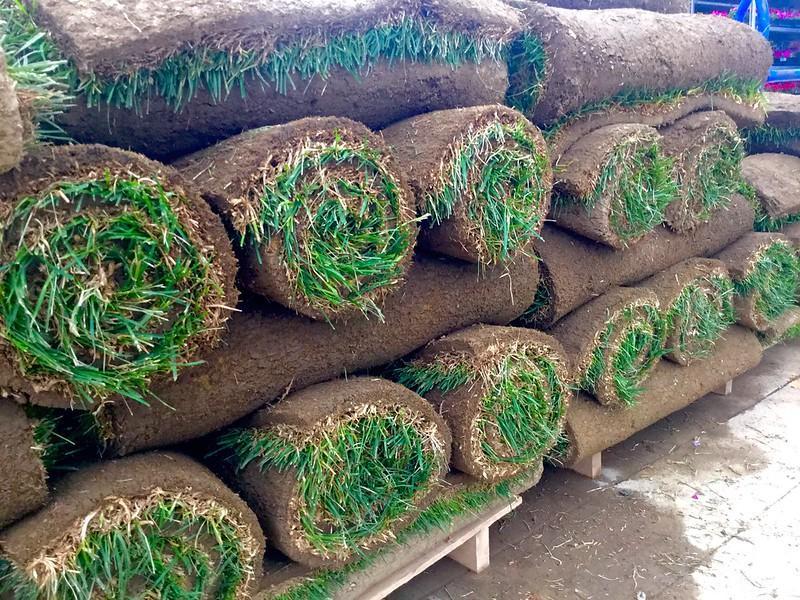
Harvested sod comprises a layer of soil and mature grass held together by netting or severed grassroots.
Whether laying sod yourself or hiring a pro to do it for you, it is crucial to understand how the process works to know it is being done right. The first step is to ensure that you have a clean, level surface. Once ready, you can lay the sod, and in my opinion, you don’t even have to remove existing grass as long as the surface level. However, some people may disagree with this and prefer a bare yard.
That said, there is a lot more to laying sod. Read on to find out!
RELATED: How Many Square Feet Are In A Pallet Of Sod | How Big Is A Pallet Of Sod?
1. Test The Soil Before Laying Sod
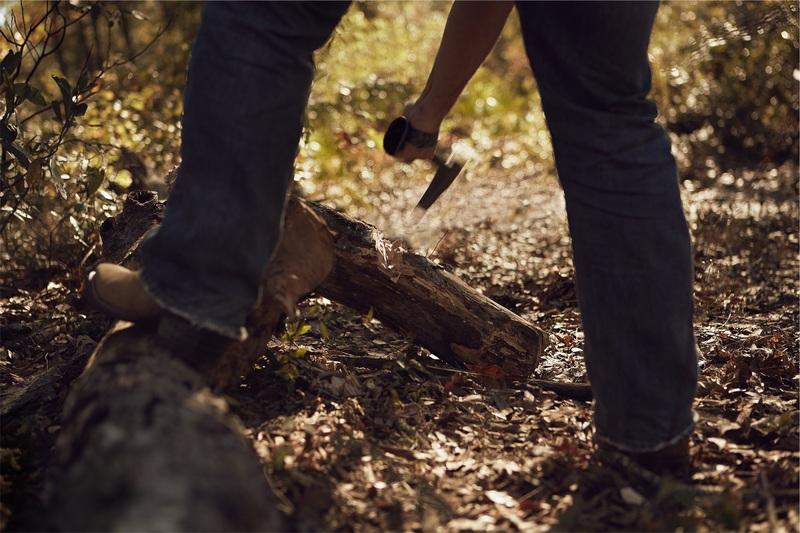
A soil test can determine the current fertility and health of your soil.
Before you spend any money preparing the soil, buying sod, and installing it on your property, I highly recommend getting or performing a soil test.
A soil test reveals tons of data about the health and chemical makeup of the soil. With this information, you will be better able to provide a healthy environment for your sod and new lawn.
You can perform a soil test yourself by purchasing a do-it-yourself soil testing kit that will give you information about the concentration of different nutrients such as potassium, calcium, nitrogen, phosphorus, and iron and the pH level of your lawn soil.
These do-it-yourself soil testing kits are inexpensive and can be bought in gardening stores.
However, if you have the option, I highly recommend getting your soil tested by your state university or county extension office. Their results will also be much more accurate, complete, and comprehensive.
In addition, the test report they will send will also contain information regarding how to correct any potential soil issues in your yard.
When Should You Get A Soil Test?
Soil can be tested at any time of the year, but experts usually agree that you should get it tested during spring or fall. It is because most lawns are planted during these times.
Also, a sample should not be collected at the last minute or immediately after applying a soil amendment to your lawn. Any chemicals used can temporarily alter your soil’s pH and other parameters, later giving wrong or inaccurate readings.
How To Get A Soil Sample?
To get a good soil sample for testing, you cannot just pick up any soil from the surface of your lawn, as that does not represent the actual soil conditions.
To collect a good sample, you will need to dig at least 6 to 8 inches deep and collect samples from various spots in your lawn.
Also, as you collect soil, ensure that any thatch, grass, or other organic debris does not come along. When done, mix all the samples and send about one to two cups of this soil mix to the soil testing facility.
And remember, the more information you give with your sample, the better/accurate your reports will be, and the facility could also help you remedy any problems better.
2. Choose The Best Grass Type To Install
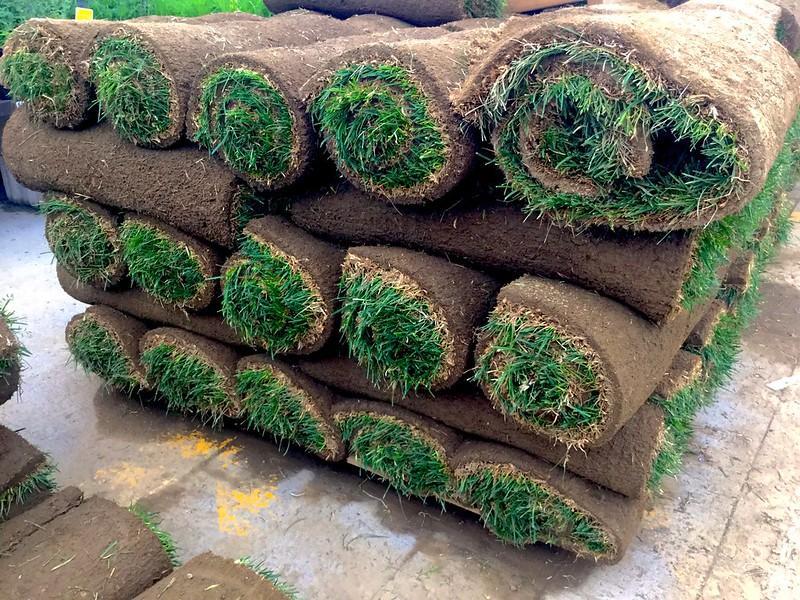
The simplest way to decide what turfgrass type is best for your lawn is by location.
Once you have the soil test reports and have made adjustments (if needed) to your lawn’s soil, it is time to pick a turfgrass type, which is probably the most fun part.
You will need to consider many factors when picking a grass, such as:
- Familiarize yourself with the different grass characteristics.
- Research the area and climate you are located in.
- How much do you want to spend? Some sods are expensive.
- What are the maintenance needs of a particular turfgrass type?
- How much water does your preferred grass type need?
- How much foot traffic your lawn receives, and if the grass can take it?
- How much sunlight your yard receives, and if it will be enough for your grass?
If you are still confused or unable to pick, I recommend collecting your soil test report, your preferences, and your lawn needs and discussing them with a turf supplier. There is no need to rush! Take as much time as you need but make sure you make the right choice.
3. Measure Your Planting Area

A critical step in establishing a lawn by sod is determining the size of the area.
Once you have decided on a turfgrass type, it is time to order the sod. First, however, you will need to determine how much sod you need. And for this, you will have to calculate the area of your property that needs to be sodded. There are many ways you can figure this out.
If it is a square lawn, it is a simple multiplication calculation.
However, calculating the area will be tricky if you have a curvy or wavy lawn. However, do not worry. You can still do it using any freely available yard measuring tools. These could easily be accessed by performing a quick Google search.
Once done, you can go ahead and order the soil. Most sod companies sell sod in the size of 6-inch wide by 24-inch long pieces. However, there might be other options.
Also, I recommend ordering a bit extra, so you do not have to reorder.
RELATED: How Much Does Sod Weigh? Transporting & Taking Care Of Your Sod
4. Kill And Remove The Old Grass
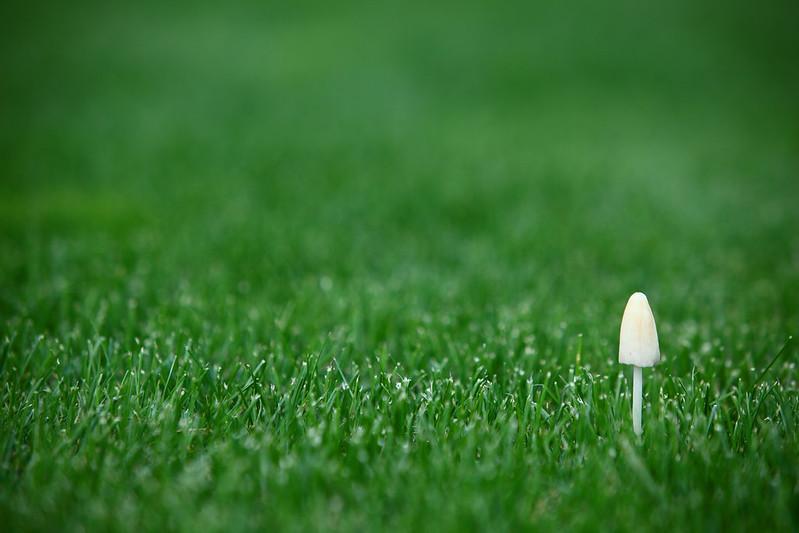
The easiest, quickest, and most effective way to kill off your lawn is to spray it with glyphosate.
Now comes the time to prepare the soil for laying the ordered sod.
To do this, you will have to remove any existing vegetation from the area where you intend to install new sod, and there are many ways to achieve that.
However, the best, easiest, and quickest is spraying the area with a non-selective herbicide.
Once again, if you intend to test your soil, please ensure that you do it before spraying your property with a herbicide, as it can affect soil pH and other soil test parameters.
The difference between selective and non-selective herbicides is that selective herbicides only kill plants, weeds, or grass they are designed for. Non-selective herbicides, on the other hand, will kill any vegetation they touch, including weeds and grass.
So, when the aim is to get rid of all the grass, the non-selective herbicide is the way to go.
However, you still have to make sure that you use it correctly. So…
- Make a plan and apply the herbicide at least 2 to 3 weeks before laying sod.
- Choose a glyphosate-based non-selective herbicide as they work the best.
- Make a second application if all the grass does not die in the first spray.
- Follow the guidelines given by the manufacturer & don’t overuse the product.
If done correctly, all the grass in your yard will die in a few days, and you can move on. Then all you have to do is remove the dead grass, and when it is dead, it is easy. You can just rent a sod cutter to remove the dead grass and other organic debris from your lawn.
5. Remove Obstacles, Till & Level The Soil
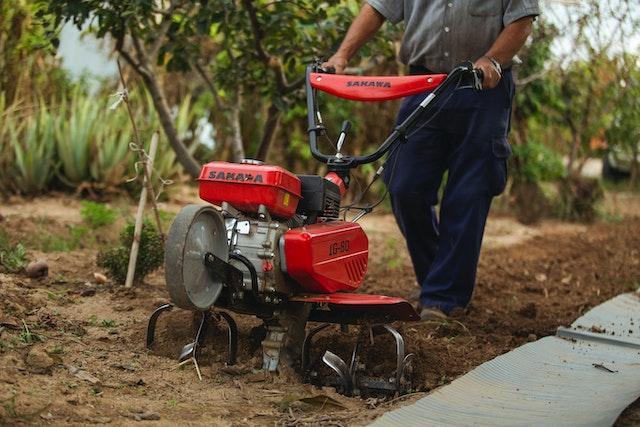
Tilling is beneficial for encouraging sod to take root quickly and develop a healthy yard.
Once you have removed all the dead grass from your yard, the next step is to ensure that it has no big chunks of soil, stones, or sticks. If there is any such thing, remove it, or it will prevent the sod from getting installed flat and correctly on your property.
Once you have removed every potential obstacle from your yard, till the soil, you can do it manually, too. Still, I recommend renting a rototiller for the best results, especially if you have a large property. A rototiller will break up and dig all the soil in your yard in no time, fixing any compaction issues and loosening the soil for healthy root growth.
Once you are done tilling, the next task is to level the yard. You can do this with a standard iron rake and while leveling, make sure to grade the soil so that you do not run into any drainage issues later. Once balanced and graded, sprinkle some water on your yard and ensure the dirt settles in, and there are no bumps or depressions.
6. Lay The Sod
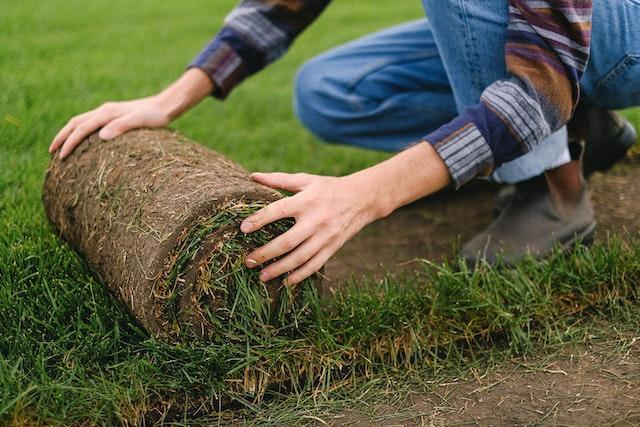
Place sod in shady areas while installing to keep it from drying out.
Once the sod is delivered to your doorstep, you will need to install it as soon as possible. So, start by dampening the soil and place the sod in a shady spot.
Also, ensure that you rake out any footprints on the lawn and see that the ground is perfectly leveled.
Once done, find the longest straight edge in your yard and roll out the first piece of sod. While laying sod, please ensure that it makes good contact with the soil below.
Do not step on the sod when installing it on your lawn, and smooth out any wrinkles by patting down on it and ensuring that there are no air rockets beneath it. After you have laid the first row, take the knife and cut off half of the next piece. It will allow you to stagger the short seams, similar to how you would do it while placing bricks.
As you lay pieces of sod, butt them against each other without overlapping and ensure no space between them. Doing this will make the seams less noticeable and ensure that the edges of the sod pieces do not dry out and die.
Once done, take a knife and make some holes in the sod to install sprinklers where needed and trim pieces of the sod against paved areas and planting beds.
7. Watering The New Sod
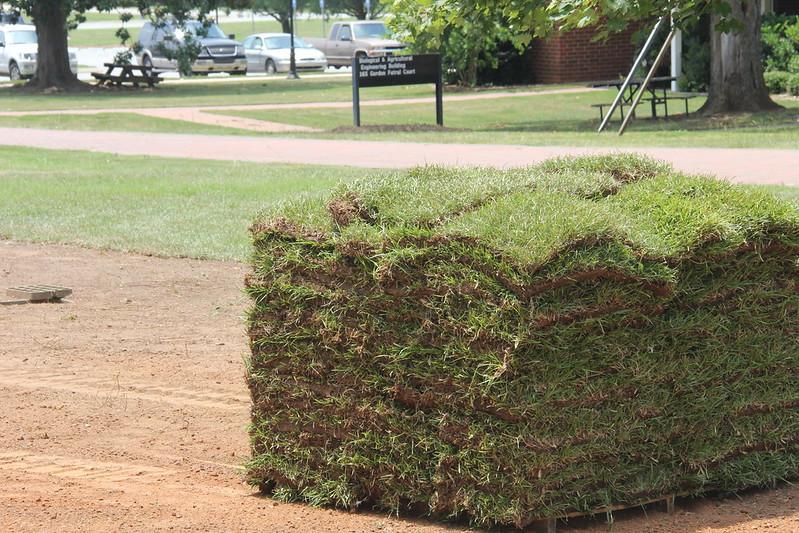
Photo Credit You will need to water your installed sod/new roots at least 2 to 4 times per day.
Once you have all the sod installed, you must water it within 30 minutes. Keep in mind that sod is made up of grass plants that require moisture to survive. Some experts and gardeners suggest wetting or moistening the sod as you lay it in your yard.
Watering New Sod
The edges of sod are particularly prone to drying out; similarly, sod laid around the borders of the lawn is also more likely to dry out. So, soak the area thoroughly.
For the next few days, you will need to water your new sod daily until it takes root in your yard, which can take about 14 to 21 days. During this time, you will also need to keep off the sod and ensure that you are watering enough to wet the soil beneath.
Moreover, I highly recommend that you water the sod during the early hours so that the grass can take in as much water as it needs and only the excess water gets evaporated during the afternoon. However, in no case water your lawn at night.
If you water at night, the excess water will not evaporate, encouraging fungal diseases.
Watering Established Sod
After the rooting-in period, you must reduce the watering frequency but increase the watering duration. It is known as watering deeply and infrequently. It will help the sod develop deeper roots, making the grass resistant to drought stress.
Avoid overwatering as it can be as harmful as underwatering for the grass.
8. Fertilizing The Sod
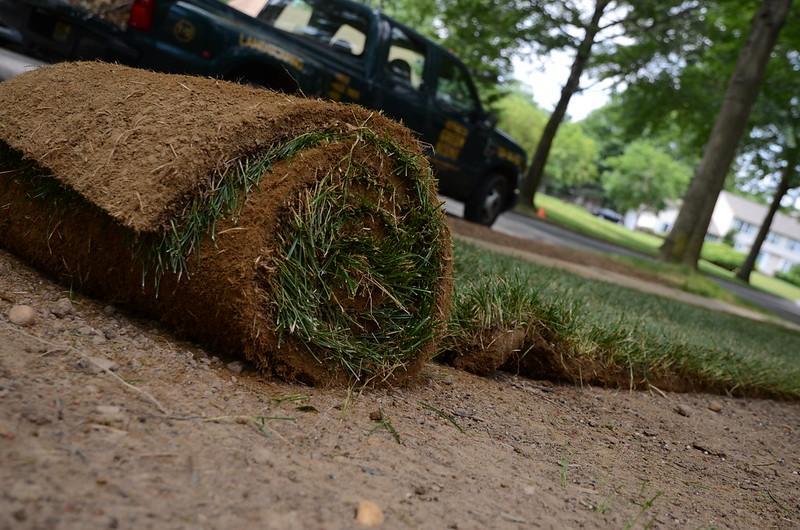
You will want to wait 30 days after installing your new sod to apply fertilizer.
You may say many online sources claim that you should fertilize your new sod one or two days after installing it with a starter fertilizer. However, you should not!
You see, grass absorbs nutrients from the soil with its roots, and sod takes about 14 to 21 days to establish its roots. So, unless the process of root establishment is complete, the sod will not be able to take up any nutrients you apply to the lawn.
Many lawn care specialists recommend waiting at least 30 days after installing fresh sod before applying fertilizer. Then, after one month, fertilize your sod with a high-phosphorus fertilizer. Phosphorus helps roots grow so that the new sod can establish successfully.
Make sure that you fertilize responsibly. Do not over-fertilize; it can cause grass burns and chemical runoff, harming flora and fauna in nearby water bodies.
RELATED: How To Grow Sod In Shady Areas Of The Lawn? Best Sod For Shady Lawns
9. Mowing The Lawn
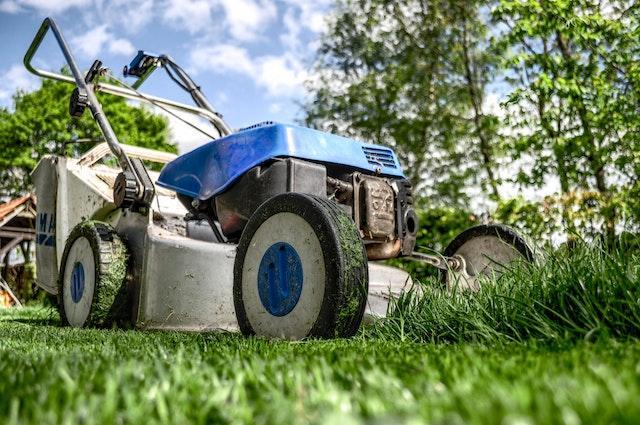
After the sod has fully rooted (approximately 5 to 6 weeks), regular mowing can commence.
Be patient and let your grass grow and reach mowing height. Do not overkill your grass before mowing too soon. And follow these tips for the best results:
- Since the grass is still fragile, do not mow with a heavy lawn mower when it reaches the mowing height. Instead, use a lightweight, push-behind mower.
- Do not mow more than one-third of the grass blade with any cutting session.
- Try to cut at the maximum recommended height to encourage a deep root system.
The Best Time To Lay Sod
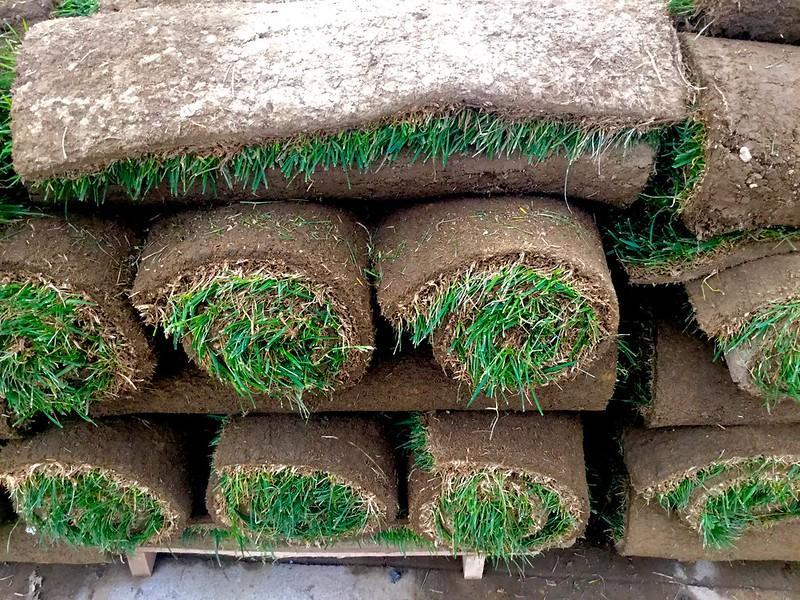
Laying down sod is best in the spring and early autumn when the temperatures are cooler.
You can lay sod at aunty time during the growing season, provided the ground is not frozen and you have enough water to keep it moist and adequately watered until it establishes the roots. However, spring and early fall are the best time to lay sod.
During these times, occasional rainfall combined with cooler temperatures helps the sod quickly take root. Some people also install sod in the summer. So, if you choose to go that way, ensure you keep the sod adequately watered and do not let it dry.
You also have to consider your area of residence to determine the best time of the year to lay sod. For example, in the northern states of the country, which favor cool-season grasses such as fescue, the best time to install the sod is in fall.
Whereas, in the southern states of the country, which favor warm-season grasses such as Zoysia and St. Augustine, spring is the best time to lay the sod.
Some Tips From Sod Experts
Here are some more tips that will help you get the most out of your sod:
- Your new sod will need plenty of sunlight to establish itself. Sod grown in the shade is weak and immune to diseases. Also, water sod in the shade less.
- Even the expert sod installer cannot tell how moist the soil is by looking. So, get a soil probe and ensure the ground is adequately watered.
- Apply more water to the sod installed near the concrete surfaces as they get hotter, and the chances of sod drying near it are relatively higher.
Final Thoughts
A lush, green lawn is a beautiful addition to any home. A stunning lawn increases curb appeal and shows you care about your property. And one of the fastest ways to establish a lawn is through sod.
However, installing sod can be a tricky process. So, please give this article another read if you have to and ensure you get everything right.
Frequently Asked Questions (FAQs)
How much does sod cost?
Prices of sod are generally quoted in price per square foot or price per pallet. Sod itself costs between $0.35 and $0.80 per square foot nationwide. On top of that, you will pay anywhere from $1 to $2 per square foot for the installation and labor costs.
What are a few common sod-laying mistakes?
Some of the most common rookie errors made by homeowners when installing sod are:
- Watering too little or too much
- Allowing the soil to be too high next to the corners
- Not staking sod on slopes
- Leaving gaps between the laid sod
- Overlapping sod
- Buying sod too soon
What is the best pattern to lay sod?
The best way to lay the sod is to spread the rolls out in a brick wall formation, alternating the cuts and ensuring there are no empty spaces (but not overlapping the edges, either).
When should you not lay sod?
You can lay sod anytime during the growing season of your turfgrass. However, anything below 40 degrees Fahrenheit is too cold, and anything above 85 degrees Fahrenheit is too hot. The ideal temperature range for laying new sod is 55 °F to 75 °F.
Should I wet the sod before rolling?
We ask that you refrain from rolling out the sod immediately following the first watering, as this may cause your feet to sink into the soft, damp soil and leave indents, resulting in a lumpy and uneven lawn. Rolling wet sod can do more damage than good.
Sources for Further Reading
Planting a New Lawn – Lawn Talk- University of Illinois Extension. (2023). Retrieved 7 January 2023, from https://web.extension.illinois.edu/lawntalk/planting/planting_a_new_lawn.cfm
Installing Sod? Remember These Ten Tips! | Gardening in the Panhandle. (2023). Retrieved 7 January 2023, from https://nwdistrict.ifas.ufl.edu/hort/2020/05/20/installing-sod-remember-these-ten-tips/
Healthy LawnsPlanting turf: Establishing a lawn from sod. (2023). Retrieved 7 January 2023, from https://ipm.ucanr.edu/TOOLS/TURF/SITEPREP/sod.html
1517 – Sodding a Lawn – PlantTalk Colorado. (2023). Retrieved 7 January 2023, from https://planttalk.colostate.edu/topics/lawns/1517-sodding-lawn/
Editor’s Recommendations
How To Water Your Lawn For Best Results? & How Often Should You Do It?
Will Frost Kill Grass Seed And How To Protect Them? The Ultimate Guide
The Best Leaf Cleanup Tools To Help You Pick And Bag Fall Leaves Easily







